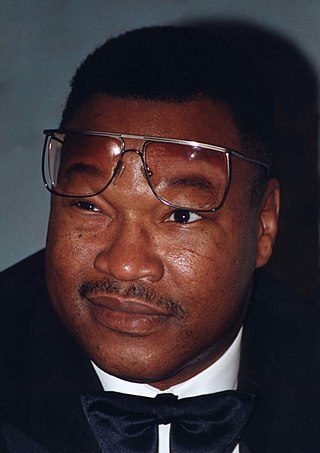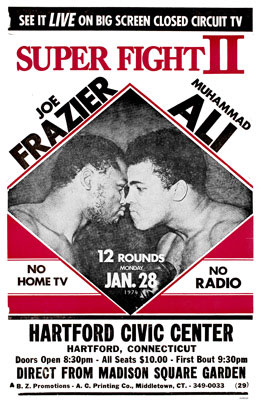
Muhammad Ali was an American professional boxer and activist. Nicknamed "the Greatest", he is regarded as one of the most significant sports figures of the 20th century and is often regarded as the greatest heavyweight boxer of all time. He held the Ring magazine heavyweight title from 1964 to 1970. He was the undisputed champion from 1974 to 1978 and the WBA and Ring heavyweight champion from 1978 to 1979. In 1999, he was named Sportsman of the Century by Sports Illustrated and the Sports Personality of the Century by the BBC.

Larry Holmes is an American former professional boxer who competed from 1973 to 2002 and was world heavyweight champion from 1978 until 1985. He is often considered to be one of the greatest heavyweight boxers of all time. He grew up in Easton, Pennsylvania, which led to his boxing nickname of the "Easton Assassin".

Muhammad Ali vs. Joe Frazier lll, billed as the "Thrilla in Manila", was the third and final boxing match between undisputed champion Muhammad Ali, and former champion Joe Frazier, for the heavyweight championship of the world. The bout was conceded after fourteen rounds on October 1, 1975, at the Araneta Coliseum in Cubao, Quezon City, Philippines, located in Metro Manila. The venue was temporarily renamed the "Philippine Coliseum" for this match. Ali won by corner retirement (RTD) after Frazier's chief second, Eddie Futch, asked the referee to stop the fight after the 14th round. The contest's name is derived from Ali's rhyming boast that the fight would be "a killa and a thrilla and a chilla, when I get that gorilla in Manila."

George Edward Foreman is an American former professional boxer, entrepreneur, minister, and author. In boxing, he competed between 1967 and 1997 and was nicknamed "Big George". He is a two-time world heavyweight champion and an Olympic gold medalist. As an entrepreneur, he is known for the George Foreman Grill.

Joseph William Frazier, nicknamed "Smokin' Joe", was an American professional boxer who competed from 1965 to 1981. Widely regarded as one of the greatest heavyweight boxers of all time, he was known for his strength, durability, formidable left hand, and relentless pressure fighting style and was the first boxer to defeat Muhammad Ali. Frazier won a gold medal at the 1964 Summer Olympics as an amateur, held the NYSAC heavyweight title from 1968 to 1973, and was the undisputed heavyweight champion from 1970 to 1973.

Kenneth Howard Norton Sr. was an American professional boxer who competed from 1967 to 1981. He is considered by some to be one of the greatest heavyweight boxers of all time. He was awarded the WBC world heavyweight championship in 1978, after winning a close split decision over Jimmy Young in a title eliminator bout, after which Leon Spinks refused to fight with him.

George Foreman vs. Muhammad Ali, billed as The Rumble in the Jungle, was a heavyweight championship boxing match on October 30, 1974, at the 20th of May Stadium in Kinshasa, Zaire, between undefeated and undisputed heavyweight champion George Foreman and Muhammad Ali. The event had an attendance of 60,000 people and was one of the most watched televised events at the time. Ali won by knockout in the eighth round.
Jerry Quarry, nicknamed "Irish" or "The Bellflower Bomber", was an American professional boxer. During the peak of his career from 1968 to 1971, Quarry was rated by The Ring magazine as the most popular fighter in the sport. His most famous bouts were against Muhammad Ali. He is often seen as being one of the Best Heavyweight Boxers never to be Champion. He beat Heavyweight Champion Floyd Patterson and top contenders Ron Lyle, Earnie Shavers, Brian London, Thad Spencer, Buster Mathis, Randy Neumann, Jack Bodell, Mac Foster and Eduardo Corletti. He accumulated damage from lack of attention to defense against larger men at the top level, no head guard sparring, and attempted comebacks in 1977, 1983 and 1992 resulted in Quarry developing an unusually severe case of dementia pugilistica.

Arnold Raymond Cream, best known as Jersey Joe Walcott, was an American professional boxer who competed from 1930 to 1953. He held the NYSAC, NBA, and The Ring heavyweight titles from 1951 to 1952, and broke the record for the oldest man to win the title, at the age of 37. That record would eventually be broken in 1994 by 45-year-old George Foreman. Despite holding the world heavyweight title for a relatively short period of time, Walcott was regarded among the best heavyweights in the world during the 1940s and 1950s.

Angelo Dundee was an American boxing trainer and cornerman. Internationally known for his work with Muhammad Ali (1960–1981), he also worked with 15 other world boxing champions, including Sugar Ray Leonard, Sean Mannion, José Nápoles, George Foreman, George Scott, Jimmy Ellis, Carmen Basilio, Luis Manuel Rodríguez, and Willie Pastrano.

József Kreul Bugner is a Hungarian born British-Australian former professional boxer who competed in the heavyweight division and actor. He holds triple nationality, originally being a citizen of Hungary and a naturalised citizen of both Australia and the United Kingdom. He unsuccessfully challenged Muhammad Ali for the heavyweight championship in 1975, losing by a unanimous decision. As an actor, he is best known for his role in the 1994 action film Street Fighter alongside Jean-Claude Van Damme and Raul Julia.

Muhammad Ali vs. Joe Frazier II, billed as Super Fight II, was a professional boxing match contested for the NABF heavyweight title. The second of the three Ali–Frazier bouts, it took place at Madison Square Garden in New York City on Monday, January 28, 1974.

James Albert Ellis was an American professional boxer. He won the vacant WBA heavyweight title in 1968 by defeating Jerry Quarry, making one successful title defense in the same year against Floyd Patterson, before losing to Joe Frazier in 1970.
Arthur Mercante Sr. was an American boxing referee. His career spanned from 1954 until 2002. Mercante's son also became a noted referee. In his youth, Arthur Mercante Sr. was a member of the Merchant Marines.

Joe Frazier vs. George Foreman, billed as The Sunshine Showdown, was a professional boxing match in Kingston, Jamaica contested on January 22, 1973, for the WBA, WBC and The Ring heavyweight championships.

George Foreman vs. Joe Frazier II, billed as "Battle of the Gladiators", was a professional boxing match contested on June 15, 1976, for the NABF heavyweight championship.
Muhammad Ali and Joe Bugner fought two boxing matches with each other. Their first bout took place on February 14, 1973; and the second for the world's heavyweight championship on July 1, 1975. Ali won both matches through unanimous decisions on points.
Muhammad Ali and Jerry Quarry fought two boxing matches with each other. The first bout took place on October 26, 1970, and the second on June 27, 1972. Ali won both fights through technical knockouts. The first match was Ali's first fight since his suspension from boxing in 1967, and the second was fought for the NABF title.

Muhammad Ali was a boxer who mastered the rope-a-dope fighting technique. He is widely regarded by many boxing commentators and historians as the greatest heavyweight boxer of all time. Boxing magazine The Ring named him number one in a 1998 ranking of greatest heavyweights from all eras. In 1999, The Associated Press voted Ali the number one heavyweight of the 20th century.
Boxing on ABC refers to a series of boxing events that have been televised on the American Broadcasting Company. Many of these events aired under the Wide World of Sports banner which began on April 11, 1964 when challenger Muhammad Ali, then known as Cassius Clay, defeated champion Sonny Liston in the seventh round. ABC's final boxing card occurred on June 17, 2000.















